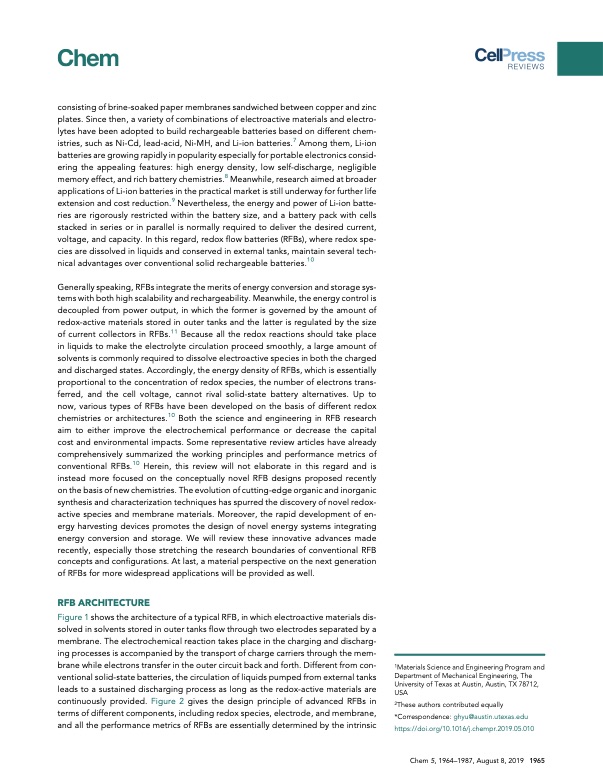
PDF Publication Title:
Text from PDF Page: 002
consisting of brine-soaked paper membranes sandwiched between copper and zinc plates. Since then, a variety of combinations of electroactive materials and electro- lytes have been adopted to build rechargeable batteries based on different chem- istries, such as Ni-Cd, lead-acid, Ni-MH, and Li-ion batteries.7 Among them, Li-ion batteries are growing rapidly in popularity especially for portable electronics consid- ering the appealing features: high energy density, low self-discharge, negligible memory effect, and rich battery chemistries.8 Meanwhile, research aimed at broader applications of Li-ion batteries in the practical market is still underway for further life extension and cost reduction.9 Nevertheless, the energy and power of Li-ion batte- ries are rigorously restricted within the battery size, and a battery pack with cells stacked in series or in parallel is normally required to deliver the desired current, voltage, and capacity. In this regard, redox flow batteries (RFBs), where redox spe- cies are dissolved in liquids and conserved in external tanks, maintain several tech- nical advantages over conventional solid rechargeable batteries.10 Generally speaking, RFBs integrate the merits of energy conversion and storage sys- tems with both high scalability and rechargeability. Meanwhile, the energy control is decoupled from power output, in which the former is governed by the amount of redox-active materials stored in outer tanks and the latter is regulated by the size of current collectors in RFBs.11 Because all the redox reactions should take place in liquids to make the electrolyte circulation proceed smoothly, a large amount of solvents is commonly required to dissolve electroactive species in both the charged and discharged states. Accordingly, the energy density of RFBs, which is essentially proportional to the concentration of redox species, the number of electrons trans- ferred, and the cell voltage, cannot rival solid-state battery alternatives. Up to now, various types of RFBs have been developed on the basis of different redox chemistries or architectures.10 Both the science and engineering in RFB research aim to either improve the electrochemical performance or decrease the capital cost and environmental impacts. Some representative review articles have already comprehensively summarized the working principles and performance metrics of conventional RFBs.10 Herein, this review will not elaborate in this regard and is instead more focused on the conceptually novel RFB designs proposed recently on the basis of new chemistries. The evolution of cutting-edge organic and inorganic synthesis and characterization techniques has spurred the discovery of novel redox- active species and membrane materials. Moreover, the rapid development of en- ergy harvesting devices promotes the design of novel energy systems integrating energy conversion and storage. We will review these innovative advances made recently, especially those stretching the research boundaries of conventional RFB concepts and configurations. At last, a material perspective on the next generation of RFBs for more widespread applications will be provided as well. RFB ARCHITECTURE Figure 1 shows the architecture of a typical RFB, in which electroactive materials dis- solved in solvents stored in outer tanks flow through two electrodes separated by a membrane. The electrochemical reaction takes place in the charging and discharg- ing processes is accompanied by the transport of charge carriers through the mem- brane while electrons transfer in the outer circuit back and forth. Different from con- ventional solid-state batteries, the circulation of liquids pumped from external tanks leads to a sustained discharging process as long as the redox-active materials are continuously provided. Figure 2 gives the design principle of advanced RFBs in terms of different components, including redox species, electrode, and membrane, and all the performance metrics of RFBs are essentially determined by the intrinsic 1Materials Science and Engineering Program and Department of Mechanical Engineering, The University of Texas at Austin, Austin, TX 78712, USA 2These authors contributed equally *Correspondence: ghyu@austin.utexas.edu https://doi.org/10.1016/j.chempr.2019.05.010 Chem 5, 1964–1987, August 8, 2019 1965PDF Image | Development of Redox Flow Batteries Based on New Chemistries

PDF Search Title:
Development of Redox Flow Batteries Based on New ChemistriesOriginal File Name Searched:
PIIS2451929419302207.pdfDIY PDF Search: Google It | Yahoo | Bing
Salgenx Redox Flow Battery Technology: Salt water flow battery technology with low cost and great energy density that can be used for power storage and thermal storage. Let us de-risk your production using our license. Our aqueous flow battery is less cost than Tesla Megapack and available faster. Redox flow battery. No membrane needed like with Vanadium, or Bromine. Salgenx flow battery
| CONTACT TEL: 608-238-6001 Email: greg@salgenx.com | RSS | AMP |